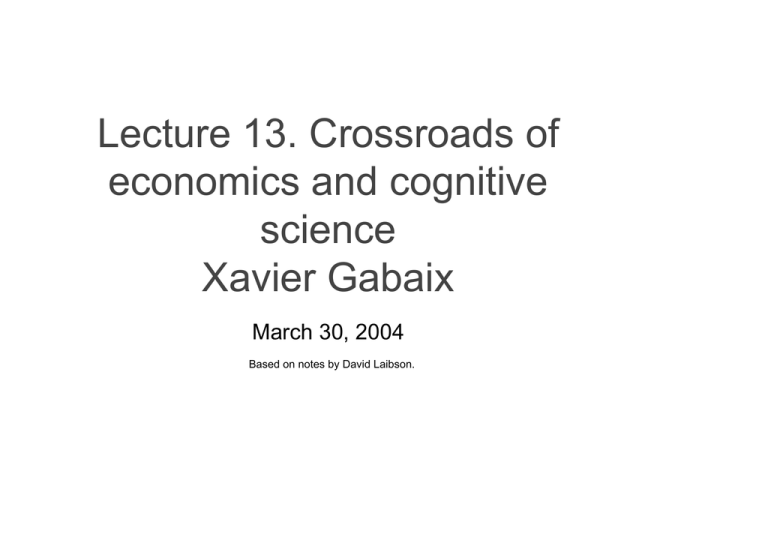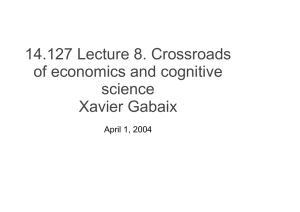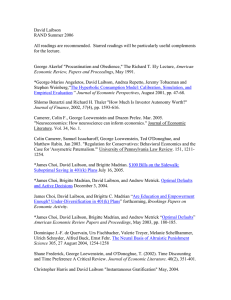Lecture 13. Crossroads of economics and cognitive science Xavier Gabaix
advertisement

Lecture 13. Crossroads of economics and cognitive science Xavier Gabaix March 30, 2004 Based on notes by David Laibson. Sanfey and Cohen’s ultimatum experiment (Sanfey et al 2003, Science, v. 300, p. 1755) • 30 subjects neuroimaged (fMRI) in the responder position of the ultimatum game • Particular neural loci are disproportionately activated when subjects receive unfair offers from humans (as opposed to fair offers from humans or fair and unfair offers from computers) – Bilateral anterior insula – Anterior cingulate cortex – Right dorsolateral prefontal cortex • Disproportionate right anterior insula activation correlates with the decision to reject unfair offers from humans (affective neural locus) Reveal Partner Reveal Fixation Reveal Offer Reveal Options Reveal Outcome Kelly gets $8 Kelly gets $0 Accept Reject You get $2 You get $0 + 12 sec 6 sec 6 sec 6 sec Subject Decides A Acceptance Rates 6 sec 100 90 80 70 60 50 40 30 20 10 0 $5:$5 $7:$3 $8:$2 Offer B $9:$1 Human Computer A) Time line for a single round of the Ultimatum Game. B) Behavioral results from the Ultimatum Game. Images adapted from Sanfey, et al. "The Neural Basis of Economic Decision-Making in the Ultimatum Game." Science 300 (2003): 1755-1758. McClure, Laibson, Loewenstein, and Cohen 2004 • Do consumers think differently about immediate rewards and delayed rewards? • Does immediacy have a special emotional drive/reward component? • Methodology: Give subjects choices over pairs of rewards. – $5 gift certificate at time t or $10 gift certificate at t’>t • Look for differential activation when immediacy is present (i.e., when t=0). Q: Which regions of the brain are differentially activated when a subject considers an immediate reward (relative to consideration of a delayed reward)? A: Limbic regions and projections from the limbic system. In other words, emotional systems are activated by immediacy. 5. Some economic questions raised by cognitive science. Preferences Knowledge Constraints Maximization Preferences: • Why do preferences vary across individuals? 1. Experiential (especially in early life) – ‘motherless’ monkeys, infant rats handled by humans (Ferris) – songbird brains affected by exposure to specie-specific songs – chronic drug use 2. Genetic – – – – – – – family, twin and adoption studies support genetic component in drug abuse vulnerability and ongoing drug dependence (Gardner) most phenotypes show around 50% heritability (controversial; see Dickens) breeding for behavioral dispositions Lewis rat strain exhibits polydrug preference (e.g., ethanol, nicotine, opiates, cocaine); related to dysfunction in DA regulation in DA forebrain reward system (Gardner) (same DA dysfunction can be induced by chronic drug use) violence: suicide, delinquent anti-social and criminal behavior (Coccaro); low serotonin? (estrogen intake decreases propensity to punish (Ernst Fehr)) • How do preferences change over time (intrapersonal variation)? 1. Long-run variations: drug use → (a) decreased DA synthesis (b) depletion of extracellular DA (c) withdrawal and tolerance; u(c-x) 2. Short-run variations (a) cue-based cravings (Siegel; Laibson; Bernheim and Rangel) (b) cue-contingent tolerance (Siegel) (c) conditioned responses (Pavlov) (d) ‘visceral’ responses (Loewenstein) (e) expectancy-based cravings (Schultz) 3. lifecycle variation (a) age declines in BSR and DA (Gardner) • What links preferences across behavioral domains? – Gene based research and neurochemical pathways research. * eating disorders * gambling * obsessive-compulsive disorder * impulse shopping * drug consumption * procrastination – e.g., reward deficiency syndrome? D2 allele? Blum – other more successful gene or multi-gene syndromes? – serotonin? – Motivational states like sexual stimulation (Ariely and Loewenstein) • Can we measure preferences without revealed preference? – – – – left/right brain asymmetry (Kahneman) real time mood measures extracellular DA? genotypes • How well do we know our own preferences? – – – – peak-end effects (Kahneman) decision utility vs. experienced utility (Kahneman) affect system dual process models (inaccessible emotional motives) • How can we change preferences? – Prozac? 1990’s bull market?! – Cognitive behavioral therapies. Constraints • For an economist interesting constraints are all external (e.g., choice sets, prices, time, wealth,…) • But, cognitive science may offer a new set of "constraints" that will mediate maximization – costs of thinking (Payne, Bettman, Johnson; Baumeister; Gabaix, Laibson, Moloche, and Weinberg) – perception and recall delays – dual process cognition • And new tools to measure cognition processes – EEG, PET, fMRI (learning application) – visors for measuring visual focus – mouselab Maximization: How do people actually make decisions? • What information is used? – emotional responses based on random cues (Damasio, LeDoux, Laibson, Bernheim and Rangel) – affect heuristic (Slovic) • Who is in control? – Neo-cortex? – Affective (limbic) system? – Does the neo-cortex sometimes leave the brain on emotional auto-pilot? (Loewenstein) • What mental modules do we use for different types of problems? (Neo-cortex, amygdala, etc...) • What decision-making skills are heritable? (e.g., abstract reasoning) • Do specific genes regulate decision-making? Serotonin? APOE? • How much decision-making can be modeled as reinforcement learning? (Camerer and Ho, Erev and Roth, Sutton and Barto) Homo Economicus (maximizing agent) • picks “actions” (including turning on the emotional autopilot; and trying to suppress it when it gets out of control) • some actions affect external world (buy gas for my car) • some actions affect internal world (direct attention or rehearse a memory) • some actions affect both (buy cocaine, which is appetite arousing) Neurochemical world (production function for cognition and reward) Technologies for... • • • • • perception, attention memory computation intuition (gut instincts; affect) non-conscious action (e.g., circulation or LeDoux's fear reflexes) • reward, affect Homo Economicus tries to increase rewards (which are produced by neurochemical world), taking into account constraints implied by external world and neurochemical world. Economists may wish to think of this as a maximization problem. The maximization is subject to both external constraints (e.g., budget constraints) and internal constraints: • • • • • • • limited perception limited memory limited attention limited calculation ability limited appetite (i.e., reward potential) limited self-knowledge limited self-control (it takes effort to control the limbic system; Baumeister) Authors who have written papers that belong in this class: • • • • • • Loewenstein (visceral effects) Kahneman (imperfect memory) Laibson (conditioned cue-initiated appetites) Romer (conditioned appetites) Mullainathan (imperfect memory) Gul and Pesendorfer (choice based appetites) • Benabou and Tirole (memory technologies) • Bernheim and Rangel (conditioned visceral effects) • Camerer and Loewenstein (JEP overview)




